Site will be
unavailable for maintenance from June. 4, 11:30 p.m., to June 5, 12:30 a.m. ET. Thank you for your
patience!
Kenya Close-up with CCF Staff Member Nicole Duciaume
Posted on 11/22/2005
Christian Children's Fund Documentation and Sponsorship Support Officer Nicole A. Duciaume traveled to Kenya in late August 2005. The purpose of Duciaume's visit was to document sponsor relations best practices and procedures at CCF-Kenya's National Office and the 12 communities she visited.
Christian Children's Fund has operated in Kenya since 1960 and currently serves approximately 750,000 children and families through its 51 program communities.
Wednesday, August 31
JAMBO!
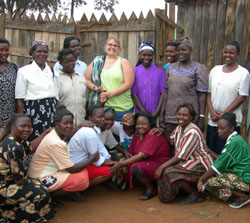 |
| Duciaume visited 12 of CCF-Kenya's 51 community program areas. |
That’s hello in Kiswahili. I arrived in Kenya yesterday and just completed my second day at Kenya’s national office. People are incredibly nice and giving. I have been busy meeting the local staff and learning about CCF's USAID/PEPFAR (President's Emergency Plan for AIDS Relief) grant. It integrates grants-based funding with sponsorship to reduce the impact of HIV/AIDS on more than 63,000 orphans, vulnerable children and adolescent youths in Thika and Kiambu districts of Central Province in Kenya.
This includes both children who have HIV/AIDS and children whose parents are living with or died from the disease. This program combines funding sources and reaches out to all children of the community, including enrolled children and those with no other CCF affiliation.
Thursday, September 1
As we left Nairobi and headed out to our program communities, we passed by several beautifully manicured lawns and impressive homes. Then, without warning, the scenery changed drastically. The beautiful homes vanished and were replaced by dwellings held together with string and mud. Eventually we turned from the main path from Nairobi and headed to Kikuyu (a single word that describes a division of Kenya, the people who live within it and the tribal language they speak).
Initially the roads were similar with marketplaces and roadside butchers and barbers. But, within a kilometer or two, the paved roads vanished and were replaced by packed clay dirt. Again, the well-traveled paths were not very rough because of the hustle and bustle of daily traffic made up of so many matutus, or minivan taxis, with people hanging out the doors. Then in the distance as we made a slow right turn, the Christian Children’s Fund logo came into view. Any semblance of a road was swallowed by the cavernous terrain.
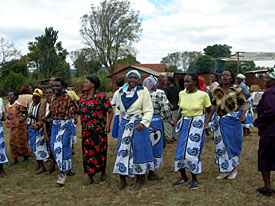 |
| In a village just north of Nairobi, CCF-assisted community members greet visitors with a celebratory dance. |
Arriving at our program community headquarters, I cannot describe the welcome I received. I toured the entire facility and met youth, parents, staff, teachers and volunteers. They were so proud of their child files, records, charts, etc. They couldn’t wait to tell me the details of their daily duties.
I learned about their reforestation and ecology programs. Special attention was bestowed on the education programs as well. Additionally I was shown the health records and growth charts for many of the children. These are used to track the physical and developmental progress of CCF-enrolled children.
Finally, they highlighted the home-based care and HIV/AIDS prevention and treatment programs.
I met the youth who are key to the overall implementation of the entire sponsor relations system. For those who’ve completed school, this is a volunteer experience. For those still attending school, their volunteer duties take place after their classes are let out for the day.
The youth volunteers are given bicycles and are provided with lunch when they deliver sponsor letters to children and translate as needed. Additionally, they are expected to bring child letters back to the project office. These volunteers spoke of their empowerment and how they meet to make decisions and create mini-projects that youth develop and run. For example, they created programs to deliver sanitary towels to school-aged girls and another program to go and visit children who are away at boarding school.
I saw CCF's seed capital loans and micro-enterprise development programs at work. One such loan was being used to create videos on HIV/AIDS and proper sanitation. Another provided funding for a crafts and toy center.
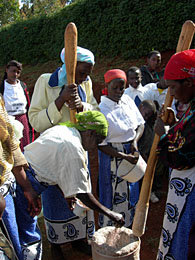 |
| Long, sturdy poles are used to pound and prepare millet and maize porridge. |
We piled into a matutu and headed to see a third micro-finance program refered to as the "Seed Capital Safety Net" program. Basically, a small portion of sponsorship funds are set aside so that mothers in the group can buy cattle, sheep, chickens, etc. The intent is that the families will breed the animals to produce more, as well as produce enough milk, eggs, etc to sell at the market and have additional income to support their families.
The path to the village covered five or 10 miles of equally treacherous, winding and cavernous terrain, the same path used by youths to deliver sponsor letters and community facilitators to do trainings or check on the children's progress.
Again, upon arrival, there was dancing, music, celebration and general jubilation. Such indelible life. The children ranged anywhere between the ages of two and 10. They had on CCF uniforms and performed dances, songs, poetry and soliloquies. The children were so brave, considering the stranger among them. As with children anywhere, they were honest and full of life. They played and ignored some instructions while toeing the line for others.
The parents also celebrated, sang, danced and chanted. They served lunch and everyone intently watched to see my reaction to the food. I put on a soldier’s face and smiled for my audience, but truthfully the food was quite good. There was boiled maize, a carrot/meat stew, rice and wheat flour tortillas, or chapati. For dessert, we delighted in a fermented maize and millet porridge served from gourds.
Just before heading back to Nairobi, we stopped off at the home of one of the hostesses, Alice, and she showed us how to prepare the maize/millet porridge. It is a multi-day effort and is served only at grand occasions such as weddings or when esteemed visitors arrive. Alice also showed me her goats that she received through the CCF micro-enterprise program.
We said our goodbyes and left into the bumpy sunset. Again, I do not think I can accurately describe the sights, sounds and emotions that I experienced this day. I felt overwhelmed by their kindness, generosity and the CCF programs I saw. Ultimately, I felt humbled by their joy and commitment.
Friday, September 2
Today, we traveled about two hours north of Nairobi toward Mt. Kenya and visited, among other things, a CCF-assisted school.
Frank, the team leader for this and three other program community areas, pointed out the school’s windows … windows that CCF funded. That may seem somewhat odd, but I should probably have mentioned that we were now relatively up in the high hills and it was cold. So, before CCF provided glass, the windows were not covered. Basically, children were learning in what amounted to brick refrigerators. He also pointed out vegetable gardens used to supplement the students’ diets, and rain collectors used to collect drinking water and water for the vegetable gardens.
Although progress is being made here, the students continue to be challenged. Conditions are cramped and educational resources are scarce.
Still, the fact that these children are receiving an education is an amazing realization of CCF's hard work and the assisted community's dedication and diligence.
Saturday, September 3
Today, we visited another nearby community.
 |
| Parents from five tribes east of Mt. Kenya celebrate with song and dance. |
What is interesting and heart wrenching about this project is that there are five tribes that coexist in this arid and seemingly uninhabitable place. Many, if not most, came to that land because they had been dislocated from their original lands — some from drought and others from tribal conflicts. Generally the tribes live in harmony, though occasional skirmishes and out-and-out clashes break out. The people are nomadic (pastoral) and the entire community seems as if it could pack up and move in the blink of an eye. There is a sense of transient existence.
Along with the mix of cultures, ethno-tribes, religions and languages, there is very real and underscoring oppression of women.
CCF is working hard in this area to build a sense of coexistence. The only common language is Kiswahili and people from each tribe are becoming increasingly tolerant of each other.
Monday, September 5
Woke up unusually early this morning and set out for another CCF-assisted community on the other side of Mt. Kenya.
Many of the same problems abound in this community: food insecurity (undernourishment due to the physical unavailibility of food), poverty, insufficient access to schooling, malnutrition, malaria and HIV/AIDS. Another issue was raised as well: alcoholism.
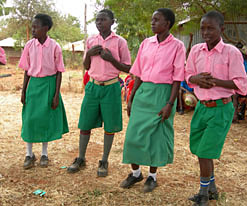 |
| CCF-assisted children, living west of Mt. Kenya, perform a poem about their understanding of HIV/AIDS and its affects on their families and communities. |
Our team leader for this cluster, Wachira, has implemented several programs that are innovative and successful. The project was amazingly well-organized: a pharmacy, bee keeping, children’s parliament, floriculture and exportation, cultural empowerment for children, reforestation and conservation, etc. The day was interesting with a good look at many of the community’s various programs and outreaches. As with many CCF-assisted communities in Kenya, CCF has begun to expand its work to include not only enrolled and sponsored children, but all the children in the community. Additionally, they have created concrete ways to make the children’s voices heard. Lastly, CCF created programs to empower youth through their own income generating endeavors.
Wednesday, September 7, 2005
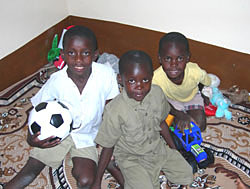 |
| Playing with CCF-donated toys, children in this Lake Victoria village are given a brief reprieve from an often harsh reality. |
We flew west today. In this region, near Lake Victoria, dire poverty, food insecurity and malnutrition were not the major perpetrators of woe. Instead, malaria and HIV/AIDS abound. Some areas we visited had an AIDS infection rate of about 15-17 percent. That is nearly one in every six people. We met the orphans of the disease and other parents struggling to survive while raising their children.
We also crossed the border momentarily into Uganda. Because they have lower import tariffs and the Kenyan Shilling is strong there, the border area is a combination flea market, garage sale and outlet mall. The border is a nebulous line barely guarded where people, livestock and diseases cross without any particular attention to boundaries.
We stayed for two days.
Monday, September 12
This morning we went to the Great Rift Valley, a land dominated by the Massai tribe. The Massai love the color red, are nomadic, believe that all cattle are inherently theirs and are cousins to the Samburu I met about two weeks earlier in north central Kenya.
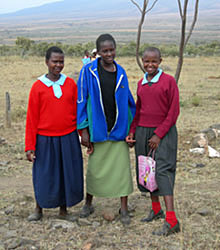 |
| Bonded by life's commonalities, these teenage Massai girls live, work and play together in Kenya's Great Rift Valley. |
The project had a focus on education, health and safe water. Education is the same story of not enough materials, facilities and teachers. There is the continued focus on the education of girls (since early marriages and female genital mutilation are common in that tribe as well). Classrooms are packed, with an average of at least 60 children per teacher without available seating, books or occasionally even rooms. The health focus is primarily on HIV/AIDS, malaria and nutrition. Often, there just isn’t access to health facilities (clinics or hospitals).
CCF created a health post for vaccinations and general ailments. Additionally, there is a maternity ward for mothers to receive prenatal care as well as have children in the facility and continue there for post birth care as well. The water problem is simply the lack of access to it. In the valley, there is a volcanic floor, so it is too hard to drill wells. Therefore, they drill wells in the surrounding mountains and pipe the water into the valley. Nothing is simple here.
Tuesday, September 13
The final project visit was in urban Nairobi. The project again has a focus on health care, though this time on HIV/AIDS, general provision of common treatments and a focus on disabilities. Because culturally there is a stigma associated with children born with disabilities (physical or mental), they are often neglected inadvertently or deliberately. Ostracized by some in the community, the children now can go to the CCF clinic and receive physiotherapy.
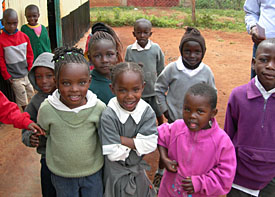 |
| Living in an impoverished area near Nairobi, children congregate for a group photo outside of their CCF-established early childhood development center. |
Additionally, the HIV/AIDS situation is spreading rapidly through the youth community. So youth are being mobilized, trained and sent into the communities to counsel other youth on the importance of changing lifestyles and voluntarily going for testing and counseling.
Education, migration and children’s rights are addressed in this urban setting, but the physiotherapy and VCT (voluntary counseling and testing) stand out for me as equally crucial to this area.
Friday, September 16
There is indelible, undeniable energy in Kenya. There is life and rhythm … a surging beat and song that pulses through the veins of this country and its people.
The people I met are so appreciative for what they have and what CCF is helping them create. They were so grounded, so passionate about life. It was inspiring, it was humbling and it was everything in between.
 |
| Samburu tribe members bid the CCF team farewell. |
Poverty isn’t about a lack of money, but rather it is the totality of lack of access to basic rights such as education, health care and the ability to earn and save wages. Poverty isn’t a concept; it is what defined someone’s past, inhibits their daily activities and limits a person’s future. But there is a way forward from poverty that includes giving access to education, health care and income generating activities. It is giving people confidence, power over their lives and the ability to make life-altering decisions that affect themselves and their communities.
CCF is making great strides to really impact and change lives. I’ve now seen it first hand and I am impressed by the dedication and commitment of the staff, volunteers and beneficiaries.
CCF-Kenya is doing extraordinary things, setting examples and really letting their actions speak volumes.
Loading...


